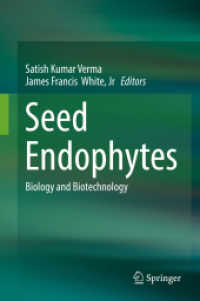- ホーム
- > 洋書
- > 英文書
- > Science / Mathematics
Full Description
This open access book is a compilation of case studies that provide useful knowledge and lessons that derive from on-the-ground activities and contribute to policy recommendations, focusing on the relevance of social-ecological production landscapes and seascapes (SEPLS) to ecosystem restoration. Building on the concept of SEPLS, the Satoyama Initiative promotes landscape approaches as integrative area-based strategies to bring together diverse stakeholders aiming to balance multiple objectives, including conservation and development, for the benefit of biodiversity and human well-being. Many of the SEPLS case studies from the International Partnership for the Satoyama Initiative (IPSI) offer rich evidence to help guide restoration efforts while advancing relevant knowledge and practices. The book highlights how the efforts in managing SEPLS can contribute to ecosystem restoration and sustainable development, looking at the strategies and approaches by which multiple stakeholders express, negotiate, and embrace their plural value perspectives of nature to restore ecosystems within a landscape or seascape. It begins with an introductory chapter followed by twelve case studies and a synthesis clarifying the relevance of the case study findings to policy and academic discussions. This book will be of interest to scholars, policymakers and professionals in the field related to sustainable development, especially on SDGs 15 and 17.
Contents
Chapter 1. Introduction.- Chapter 2. Community-Based Woodland Restoration for Livelihoods and Sustainable Wood Fuel Utilisation in the Mole Ecological Landscape, Ghana.- Chapter 3. Community- Based Rangeland Restoration for Climate Resilience and Pastoral Livelihoods in Chyulu, Kenya.- Chapter 4. Initiation of SEPLS Approach from World Peace Biodiversity Park (WPBP), Pokhara in Panchase Region of the Nepal.- Chapter 5. Community-Based Restoration of Agroforestry Parklands in Kapelebyong District, North Eastern Uganda.- Chapter 6. Farmland Management Strategies by Smallholder Farmers in the Mount Bamboutos Landscape in Cameroon.- Chapter 7. Traditional Regenerative Agriculture as a Sustainable Landscape Approach: Lessons from India and Thailand.- Chapter 8. Restoring Rice Paddies and Rice Agro-Ecosystem Services through a Participatory Seed Conservation and Exchange Programme.- Chapter 9. Community-Based Approach to Wetland Restoration - Case Study of the Songor Wetland, Ghana.- Chapter 10. An Integrated Seascape Approach to Revitalise Ecosystems and Livelihoods in Shimoni-Vanga, Kenya.- Chapter 11. Engaging Local People in Conserving the Socio-Ecological Production Landscape and Seascape by Practicing Collaborative Governance in Mao'ao Bay, Chinese Taipei.- Chapter 12. Multi-Stakeholder Platform for Coastal Ecosystem Restoration and Sustainable Livelihood in Sanniang Bay in Guangxi, South China.- Chapter 13. Capacitating Philippine Indigenous and Local Institutions and Actualising Local Synergies on Restorative Ridge to Reef Biodiversity Conservation for Food Security and Livelihoods.- Chapter 14. Synthesis: Ecosystem Restoration in the Context of Socio-Ecological Production Landscapes and Seascapes (SEPLS).








